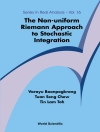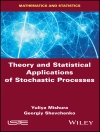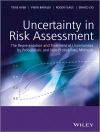In this fully revised and expanded edition of Smooth Tests of
Goodness of Fit, the latest powerful techniques for assessing
statistical and probabilistic models using this proven class of
procedures are presented in a practical and easily accessible
manner. Emphasis is placed on modern developments such as
data-driven tests, diagnostic properties, and model selection
techniques. Applicable to most statistical distributions, the
methodology described in this book is optimal for deriving tests of
fit for new distributions and complex probabilistic models, and is
a standard against which new procedures should be compared.
New features of the second edition include:
* Expansion of the methodology to cover virtually any statistical
distribution, including exponential families
* Discussion and application of data-driven smooth tests
* Techniques for the selection of the best model for the data,
with a guide to acceptable alternatives
* Numerous new, revised, and expanded examples, generated using R
code
Smooth Tests of Goodness of Fit is an invaluable resource
for all methodological researchers as well as graduate students
undertaking goodness-of-fit, statistical, and probabilistic model
assessment courses. Practitioners wishing to make an informed
choice of goodness-of-fit test will also find this book an
indispensible guide.
Reviews of the first edition:
‘This book gives a very readable account of the smooth tests
of goodness of fit. The book can be read by scientists having only
an introductory knowledge of statistics. It contains a fairly
extensive list of references; research will find it helpful for the
further development of smooth tests.’ —T.K. Chandra,
Zentralblatt für Mathematik und ihre Grenzgebiete, Band 73,
1/92′
‘An excellent job of showing how smooth tests (a class of
goodness of fit tests) are generally and easily applicable in
assessing the validity of models involving statistical
distributions….Highly recommended for undergraduate and graduate
libraries.’ —Choice
‘The book can be read by scientists having only an
introductory knowledge of statistics. It contains a fairly
extensive list of references; researchers will find it helpful for
the further development of smooth tests.’—Mathematical
Reviews
‘Very rich in examples . . . Should find its way to the desks
of many statisticians.’ —Technometrics
Содержание
Preface.
1 Introduction.
1.1 The Problem Defined.
1.2 A Brief History of Smooth Tests.
1.3 Monograph Outline.
1.4 Examples.
2 Pearson’s X2 Test.
2.1 Introduction.
2.2 Foundations.
2.3 The Pearson X2 Test — an Update.
2.4 X2 Tests of Composite Hypotheses.
2.5 Examples.
3 Asymptotically Optimal Tests.
3.1 Introduction.
3.2 The Likelihood Ratio, Wald, and Score Tests for a Simple Null Hypothesis.
3.3 The Likelihood Ratio, Wald and Score Tests for Composite Null Hypotheses.
3.4 Generalized Score Tests.
4 Neyman Smooth Tests for Simple Null Hypotheses.
4.1 Neyman’s 2 test.
4.2 Neyman Smooth Tests for Uncategorized Simple Null Hypotheses.
4.3 The Choice of Order.
4.4 Examples.
4.5 EDF Tests.
5 Categorized Simple Null Hypotheses.
5.1 Smooth Tests for Completely Specified Multinomials.
5.2 X2 Effective Order.
5.3 Components of X2P.
5.4 Examples.
5.5 Class Construction.
5.6 A More Comprehensive Class of Tests.
5.7 Overlapping Cells Tests.
6 Neyman Smooth Tests for Uncategorized Composite Null Hypotheses.
6.1 Neyman Smooth Tests for Uncategorized Composite Null Hypotheses.
6.2 Smooth Tests for the Univariate Normal Distribution.
6.3 Smooth Tests for the Exponential Distribution.
6.4 Smooth Tests for Multivariate Normal Distribution.
6.5 Smooth Tests for the Bivariate Poisson Distribution.
6.6 Components of the Rao-Robson X2 Statistic.
7 Neyman Smooth Tests for Categorized Composite Null Hypotheses.
7.1 Neyman Smooth Tests for Composite Multinomials.
7.2 Components of the Pearson-Fisher Statistic.
7.3 Composite Overlapping Cells and Cell Focusing X2Tests.
7.4 A Comparison between the Pearson-Fisher and Rao-Robson X2 Tests.
8 Neyman Smooth Tests for Uncategorized Composite Null Hypotheses: Discrete Distributions.
8.1 Neyman Smooth Tests for Discrete Uncategorized Composite Null Hypotheses.
8.2 Smooth and EDF Tests for the Univariate Poisson Distribution.
8.3 Smooth and EDF Tests for the Binomial Distribution.
8.4 Smooth Tests for the Geometric Distribution.
9 Construction of Generalized Smooth Tests: Theoretical Contributions.
9.1 Introduction.
9.2 Smooth Test Statistics with Informative Decompositions.
9.3 Generalized Smooth Tests with Informative Decompositions.
9.4 Efficiency.
9.5 Diagnostic Component Tests.
10 Smooth Modelling.
10.1 Introduction.
10.2 Model Selection through Hypothesis Testing.
10.3 Model Selection Based on Loss Functions.
10.4 Goodness of Fit Testing after Model Selection.
10.5 Correcting the Barton Density.
11 Generalized Smooth Tests for Uncategorized Composite Null Hypotheses.
11.1 Introduction.
11.2 Generalized Smooth Tests for the Logistic Distribution.
11.3 Generalized Smooth Tests for the Laplace Distribution.
11.4 Generalized Smooth Tests for the Extreme Value Distribution.
11.5 Generalized Smooth Tests for the Negative Binomial Distribution.
11.6 Generalized Smooth Tests for the Zero-Inflated Poisson Distribution.
11.7 Generalized Smooth Tests for the Generalized Pareto Distribution.
Appendix A: Orthonormal Polynomials and Recurrence Relations.
Appendix B: Parametric Bootstrap p-Values.
Appendix C: Some Details for Particular Distributions.
References.
Subject Index.
Author Index.
Example Index.
Об авторе
John Rayner is a Professor of Statistics at the University of Newcastle (Australia). He obtained his BA and MA from the University of Sydney and Ph D from the University of Wollongong. He has held appointments at the Universities of New England, Otago, and Wollongong in addition to Newcastle. John is Associate Editor of the Journal of Applied Mathematics and Decision Sciences. He has over 100 publications in the fields of statistical model assessment and nonparametric statistics, has co-edited five books/proceedings/special journal issues and authored three research books.
Olivier Thas is an Associate Professor in biostatistics at Ghent University (Belgium). He joined the academic staff there in 1995 as a research assistant and was promoted to lecturer in 2001 after successful completion of his Ph D in applied biological sciences. To-date Thas has ca. 50 publications in peer reviewed journals.
John Best is a Conjoint Academic at the University of Newcastle. After a number of years at the Commonwealth Bureau of Meterology (1967/70) and the Commonwealth Scientific and Industrial Research Organisation (CSIRO) (1970-2001) he accepted an honorary principal research fellowship at the University of Wollongong (2001), where he also obtained his Ph D in 1999. Best has over 100 scientific publications to his name.












